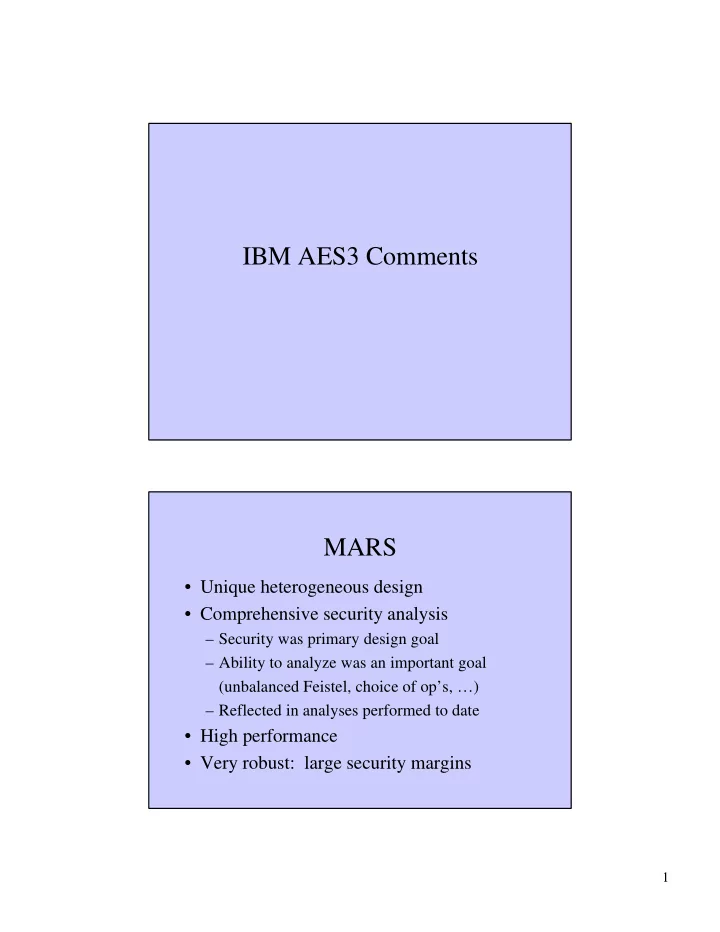

IBM AES3 Comments MARS • Unique heterogeneous design • Comprehensive security analysis – Security was primary design goal – Ability to analyze was an important goal (unbalanced Feistel, choice of op’s, …) – Reflected in analyses performed to date • High performance • Very robust: large security margins 1
Performance/Complexity/Security Cipher Performance Setup Complexity Security C Mb/sec* Clocks* LOC* R/Min R RC6 94.2 1875 116 1.0 MARS 69.4 2134 424 1.6 Twofish 68.8 8493-15616 496 1.6 Rijndael 50.5-70.3 207-1983 449 1.3-1.8 Serpent 26.7 1296 623 1.9 * Performance numbers and lines-of-C-code refer to Brian Gladman's implementation MARS Pseudo-Code (A,B,C,D) = (A,B,C,D) + (K[0],K[1],K[2],K[3]) For i = 0 to 7 do { B = (B ⊕ S 0 [A]) + S 1 [A>>>8] mixing C = C + S 0 [A>>>16] D = D ⊕ S 1 [A>>>24] A = (A>>>24) + B(if i=1,5) + D(if i=0,4) (A,B,C,D) = (B,C,D,A) } For i = 0 to 15 do { R = ((A<<<13) × K[2i+5]) <<< 10 M = (A + K[2i+4]) <<< (low 5 bits of (R>>>5)) core L = (S[M] ⊕ (R>>>5) ⊕ R) <<< (low 5 bits of R) B = B +L(if i<8) ⊕ R(if i ≥ 8) C = C + M D = D ⊕ R(if i<8) + L(if i ≥ 8) (A,B,C,D) = (B,C,D,A<<<13) } For i = 0 to 7 do { A = A - B(if i=3,7) - D(if i=2,6) Mixing −1 B = B ⊕ S 1 [A] C = C - S 0 [A<<<8] D = (D - S 1 [A<<<16]) ⊕ S 0 [A<<<24] (A,B,C,D) = (B,C,D,A<<<24) } (A,B,C,D) = (A,B,C,D) - (K[36],K[37],K[38],K[39]) 2
Note on “Security Margins” • Common measure: “how many more rounds than what is necessary by cryptanalysis” • This is quite meaningless – Without a major breakthrough in analysis, all five candidates are secure – But such breakthrough will render current bounds completely useless – How to protect against such event? Question your trust • Real security margins: question the very thing in the cipher which you trust to be secure • Example: both MARS and RC6 rely on the strength of data-dependent rotations – If a radically better understanding of this operation is discovered, RC6 will be most likely be broken – MARS probably not, since it has many fail-stop mechanisms • E.g., S-box, wrapper layers, … 3
MARS design philosophy 1. Design a strong cipher – Other ciphers stopped here 2. Add many fail-stop mechanisms, in case your underlying assumptions are wrong – As many fail-stop mechanisms as possible, while maintaining a workable solution • Fail-stop mechanisms cost sometimes – MARS is still suitable for all environments Other AES Finalists • RC6 + High performance – Security margin, “single point of failure” • Rijndael + Performance with 128-bit key – Performance with 256-bit key – Non-traditional: “algebraic structure” may lead to attack • Serpent + Security margin – Performance • Twofish + Performance – “Key dependent S-box”: key setup time, hard to analyze – The least understood cipher. Very steep learning curve. 4
Best AES Choice: MARS • Only candidate with hybrid structure – “Future-proof” design, many fail-stop mechanisms • Carefully analyzed security – Independent analysis confirms claimed security • Utilizes time-tested cipher methods – Feistel, S-box, data-dependent rotations, … • Balanced Security/Performance 5
Recommend
More recommend